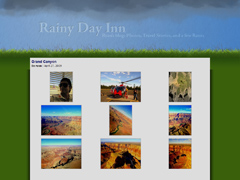“Spec Work”
I’ve read a couple of interesting blog posts (and comment threads) lately regarding what’s known in this industry as “spec work” — short for “speculative work.”

Basically what this means is working for free. Investors speculate on whether their investments will increase or decrease in value. In the design profession, the objection to spec work can be put this way: you’re speculating with a large risk for a very small reward. You volunteer your valuable time working on your craft, all for the chance of being awarded the contract. An investment banker would never take that bet. The client in this case gets a lot of free design work, and the “winning” designer is probably most often the one willing to do the most for the least pay. This is one reason why many respected designers, the AIGA, and other organizations like NO!SPEC strongly advise all designers against this type of work. And it’s not just about the individual instance of the free work, but it also encourages the lead/client and indeed the general public to see this type of business practice as the “norm”.
But there’s another major disadvantage to working on spec, from the both the designer’s AND the client’s perspective. The fact is that a good design, that meets the client’s needs, involves the PROCESS as much or more than the execution of the design itself. With this kind of work, the “design brief” is often something like “I’ll know it when I see it.” A professional designer who’s good at his/her job will engage the client to find their specific needs, the intended emotional impact of the work, research the intended market and competition if any, etcetera etcetera. When there is simply a prompt of “make a design for my company, and if I like it I’ll buy it”, there’s virtually no way for either party to guarantee that the design will match the intention.
Now, why am I writing about this? Well… um… I did some spec work yesterday, and I have a sick feeling in my stomach as a result. The results of the “contest” are still to be decided, and there’s still a chance I’ll be selected for the work. Regardless, it feels bad for two reasons. (1) It feels like grovelling, offering my services for free; and (2) I feel like I could do a much better job if I invested more time in communicating with the client, doing mockups and revisions, and generally carrying out the transaction in a more professional way. The problem with that is that it’s a catch 22 — either I invest a lot more time to make a better end product that still might not win, or I stick with the simple mockups I did in a few hours which I know could be better.
So knowing all this, why did I do it? Mostly for the same reason the apologists often cite as the one example where it might make sense. Aspiring designers without much of a reputation or portfolio to speak of. See, I’m already in that classic of all catch 22s where I need experience in order to get experience. So I did some work for free, and hey, I might just convert those mockups into demo WordPress themes anyway, just for the portfolio material. But I think the bottom line here is that you’ll be treated how you expect to be treated. Fake it ’till you make it, right? Act like a professional, and you are one.
If anyone happens to read this, I’d be interested to hear opinions in the comments.